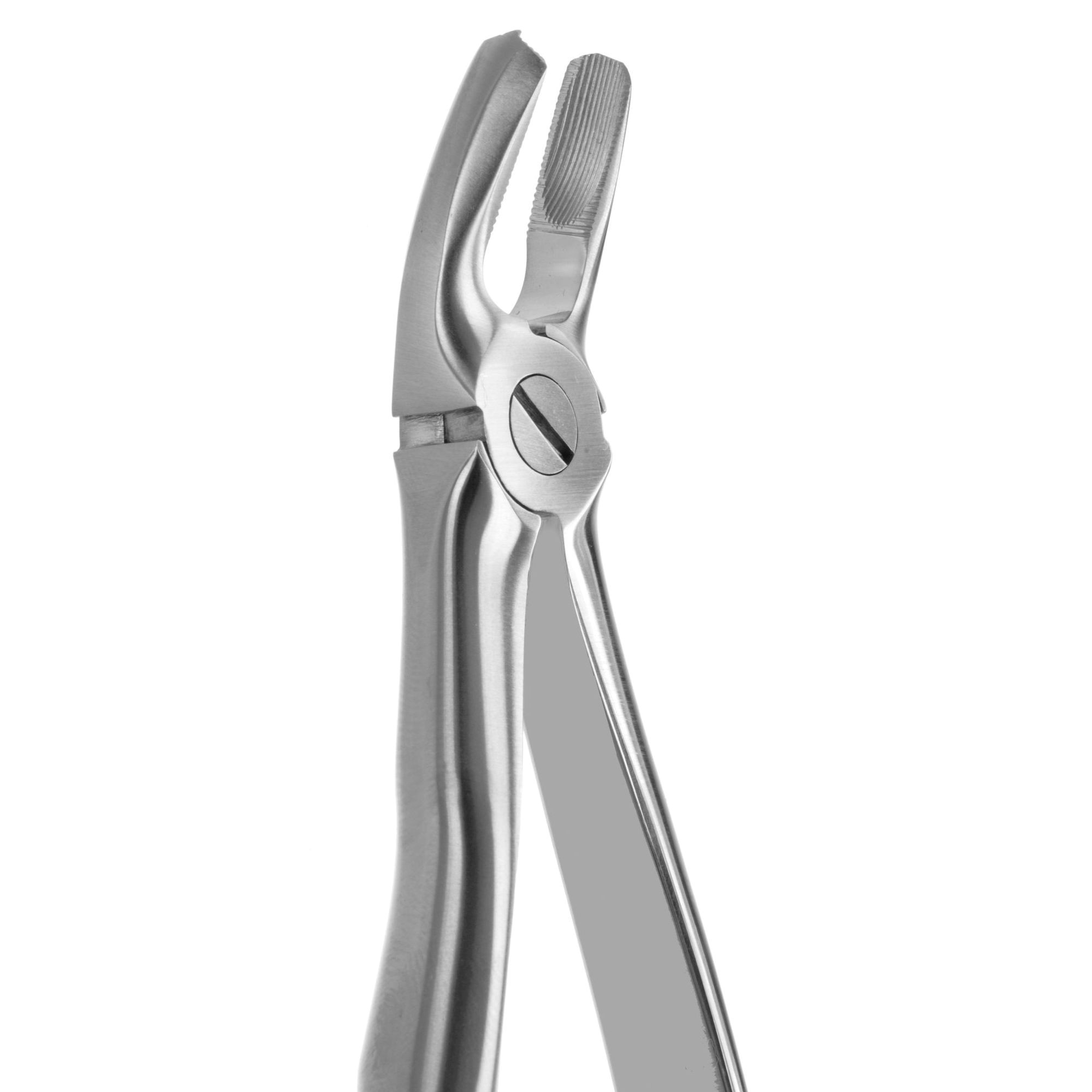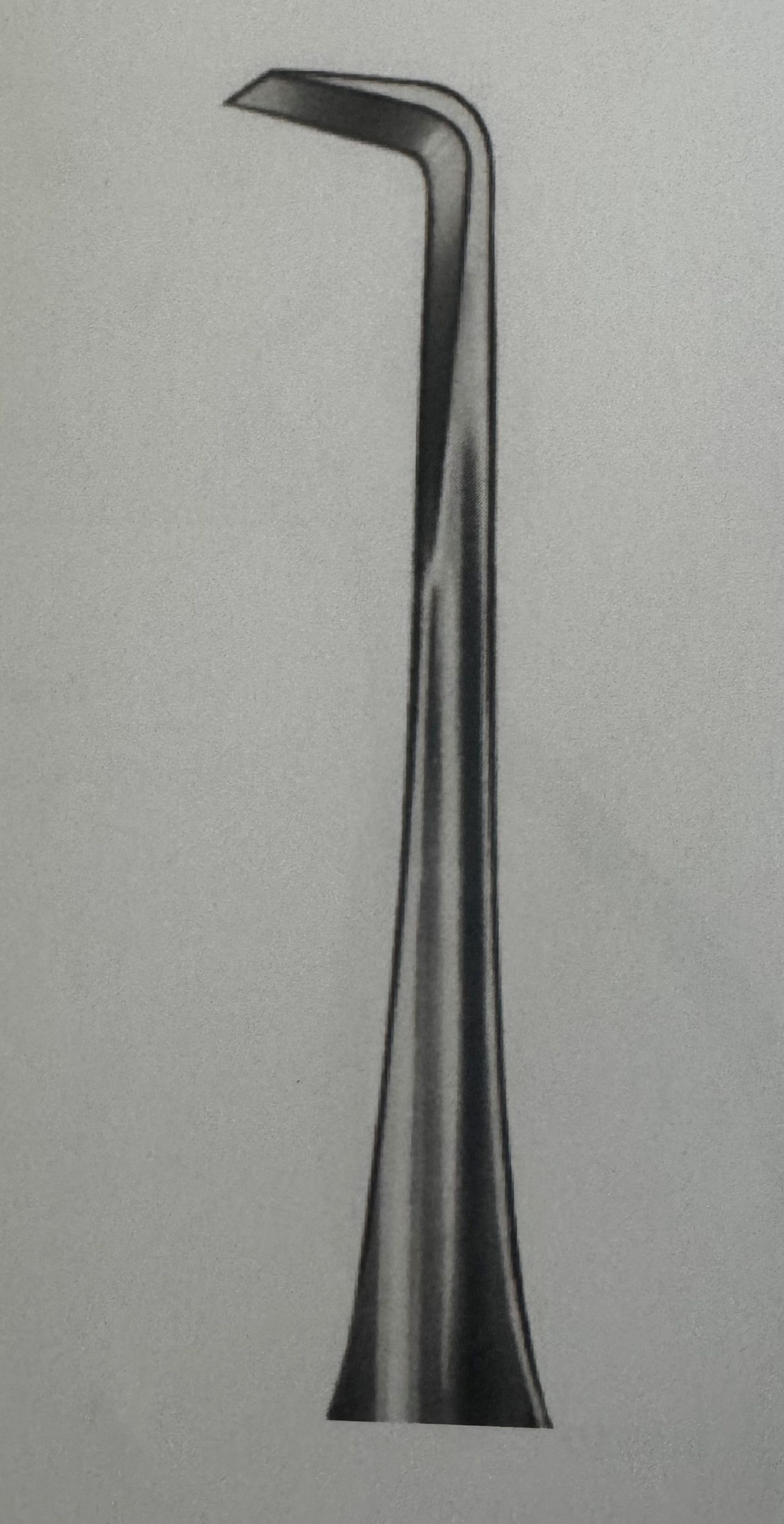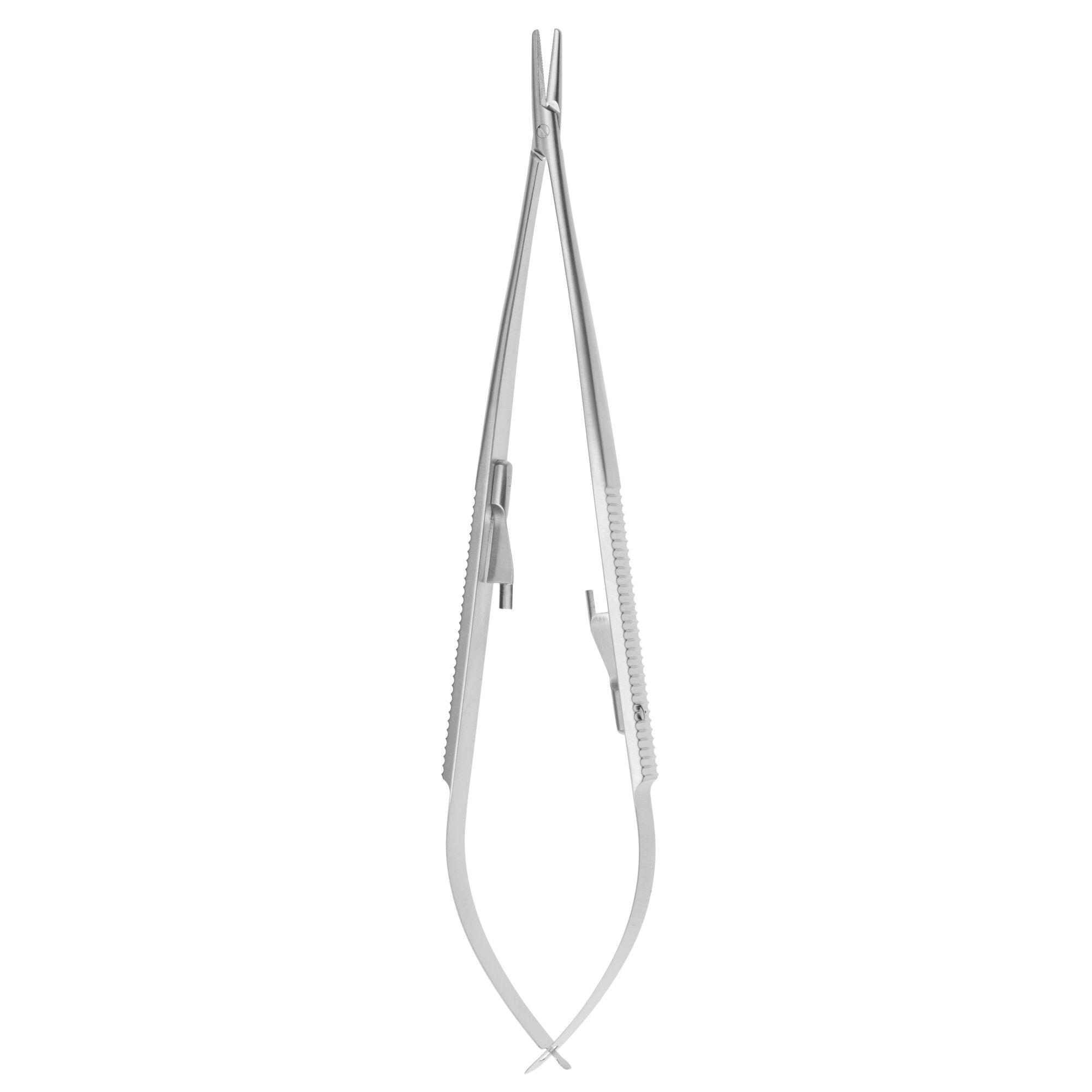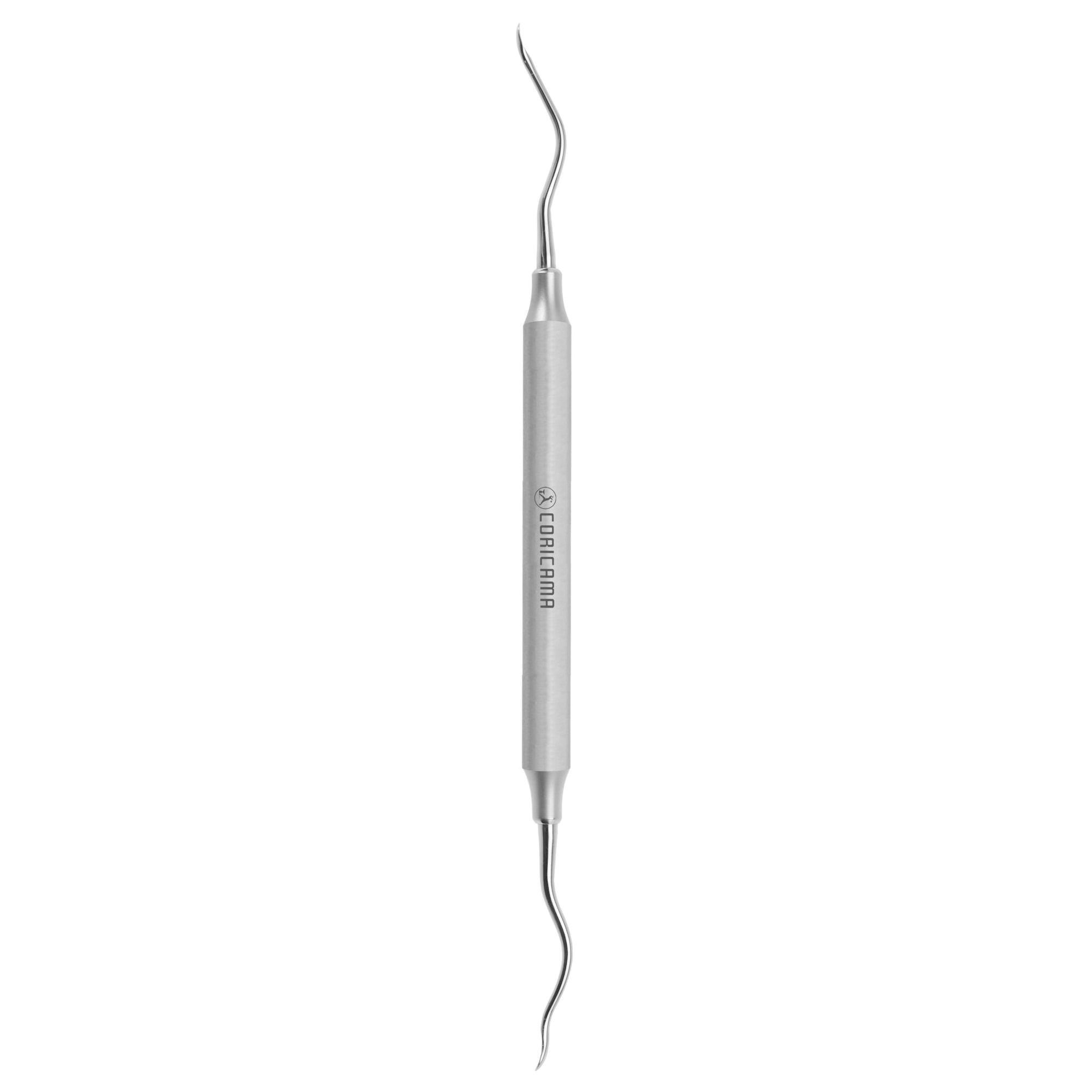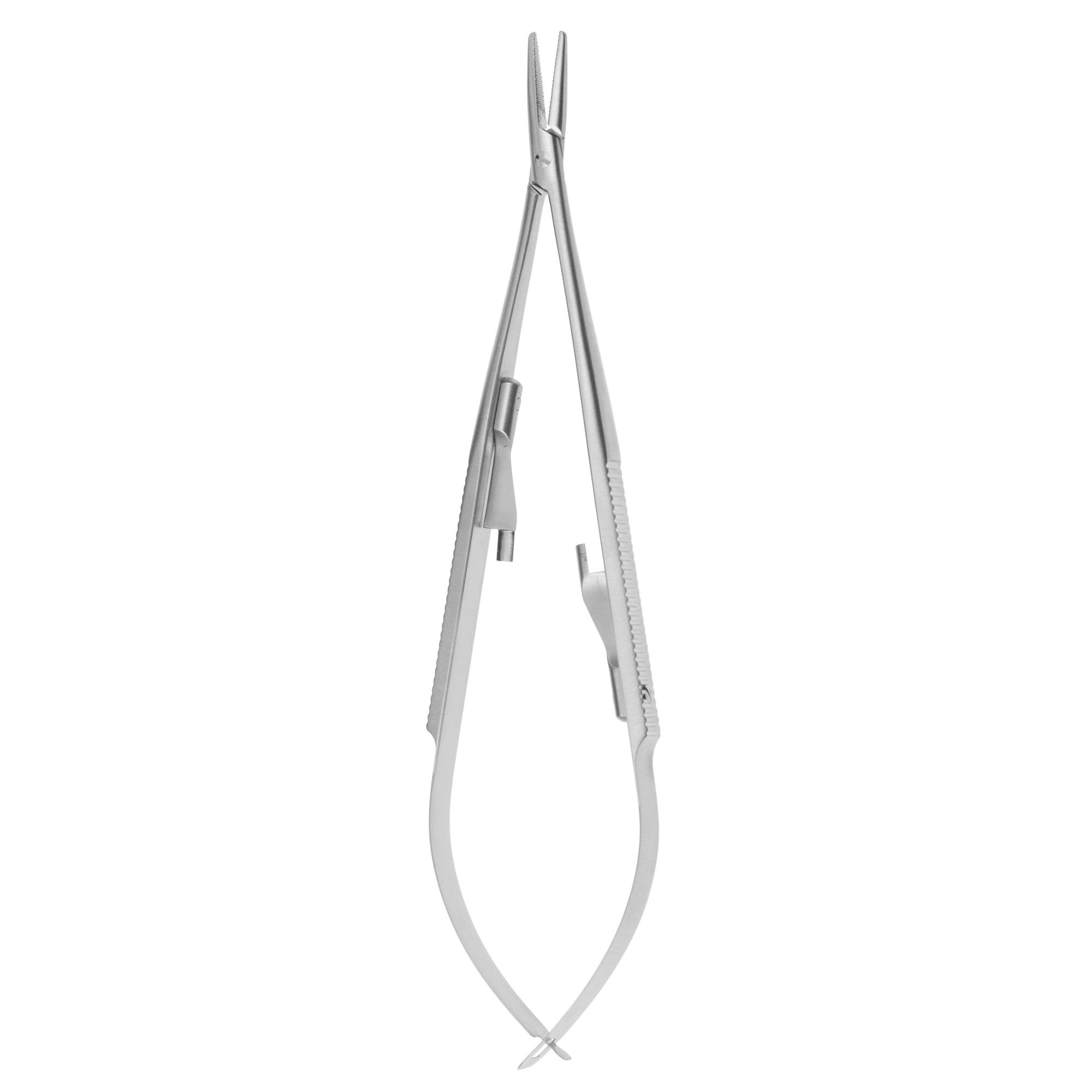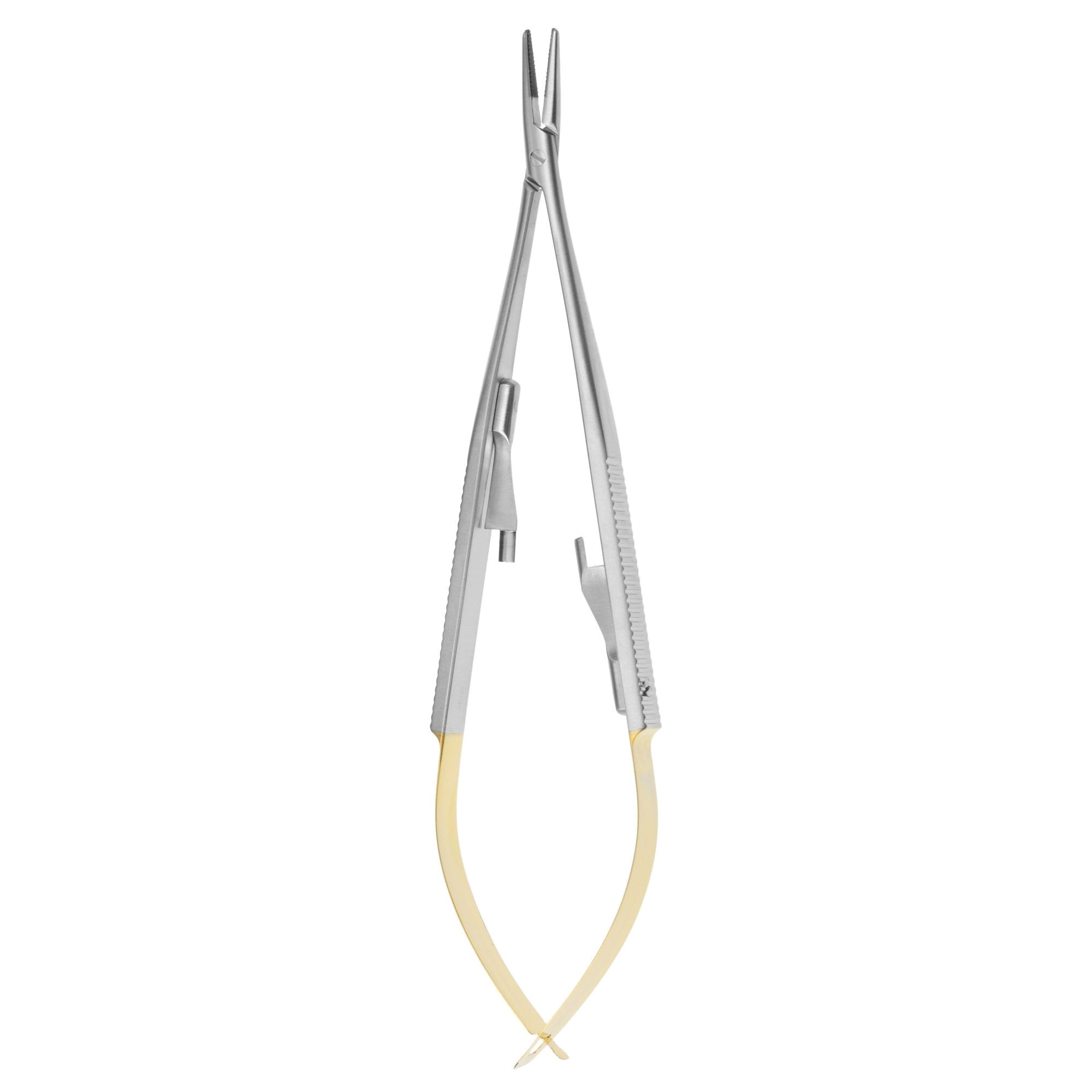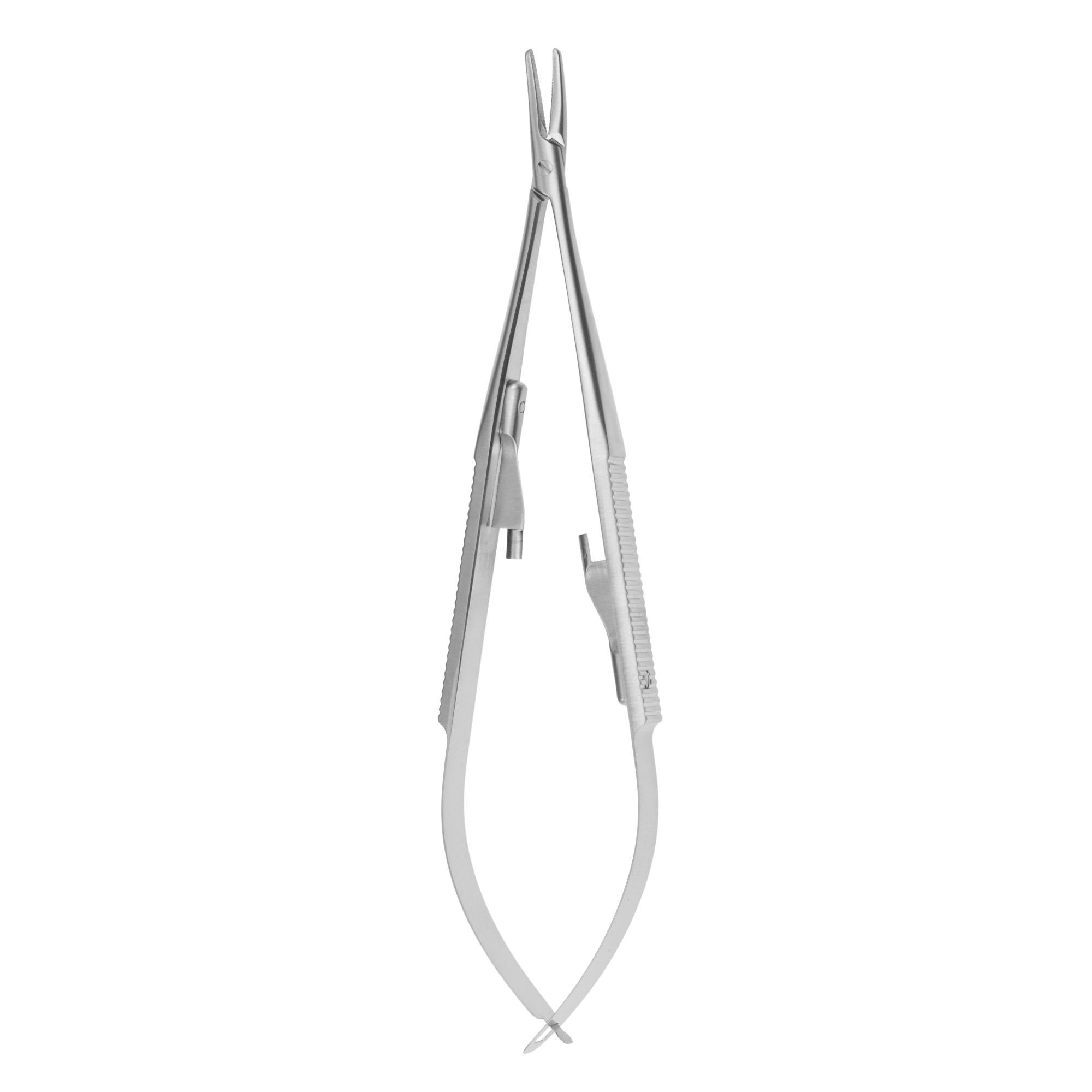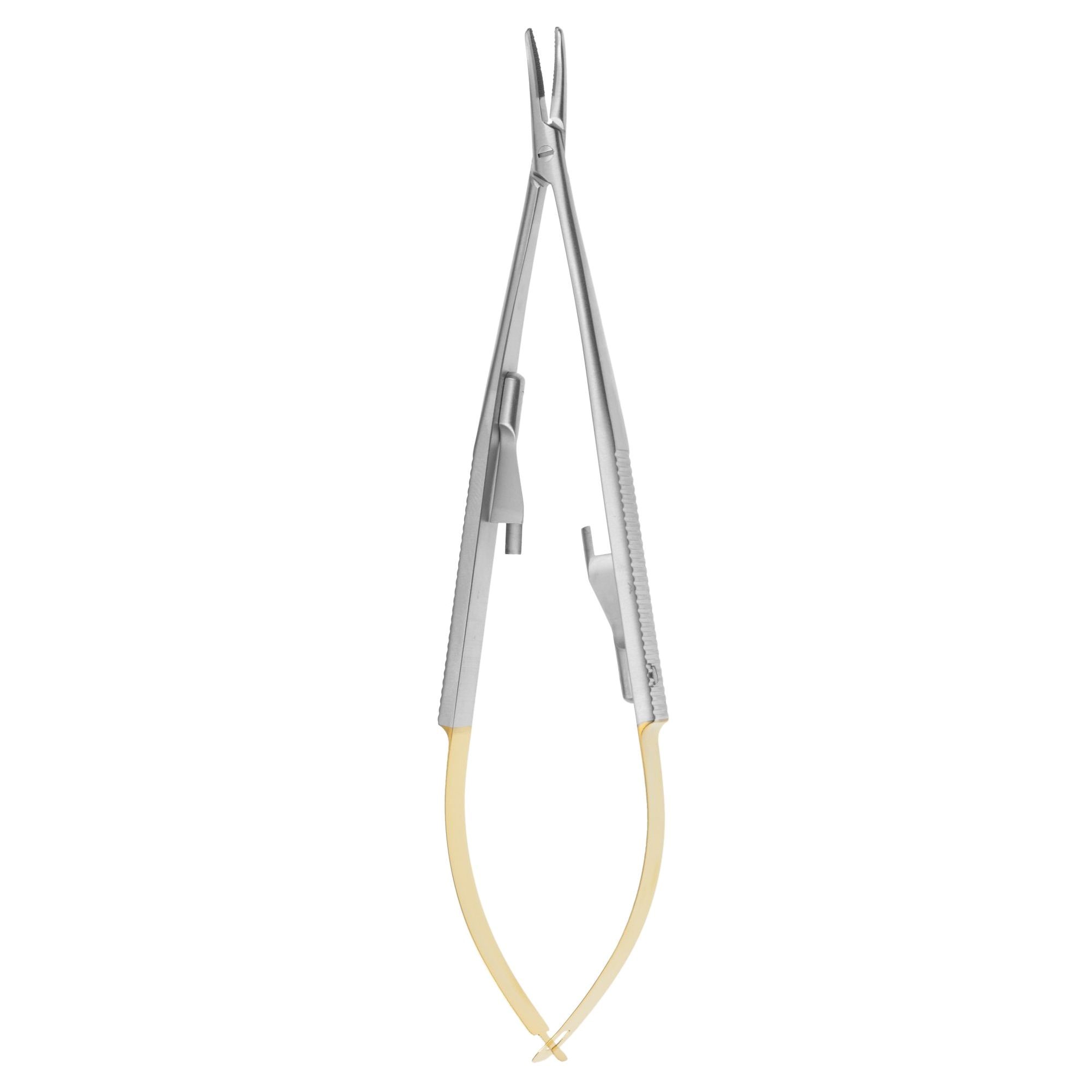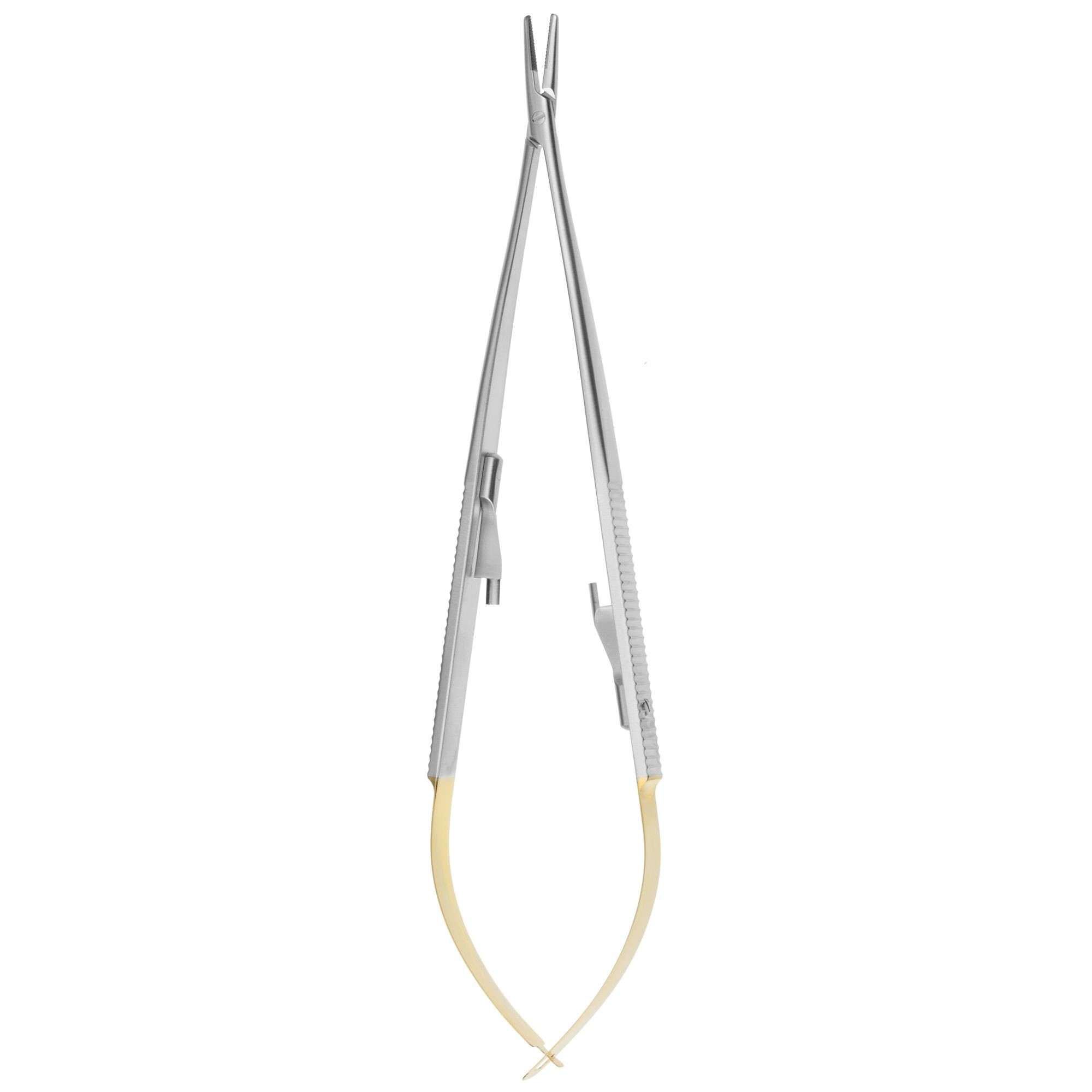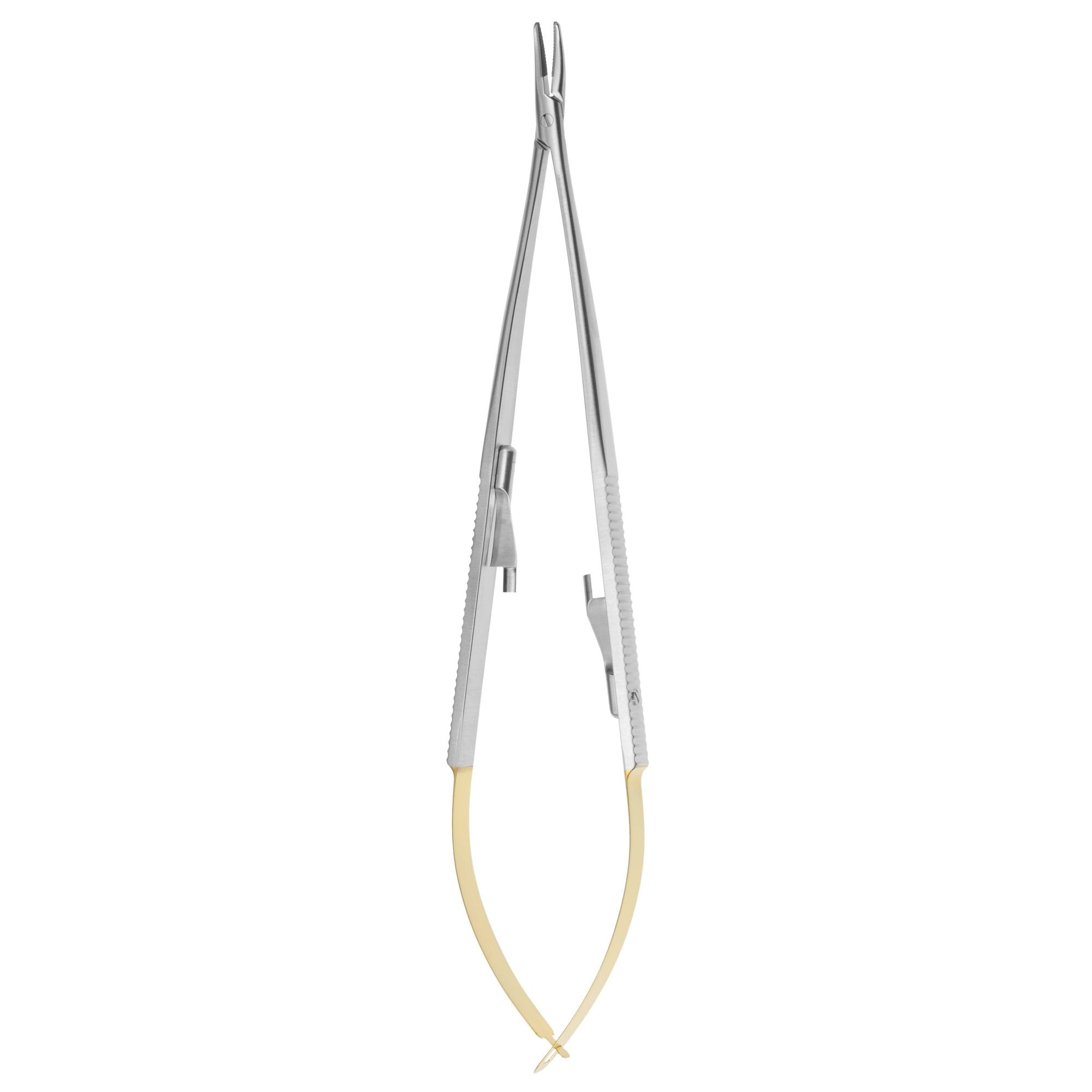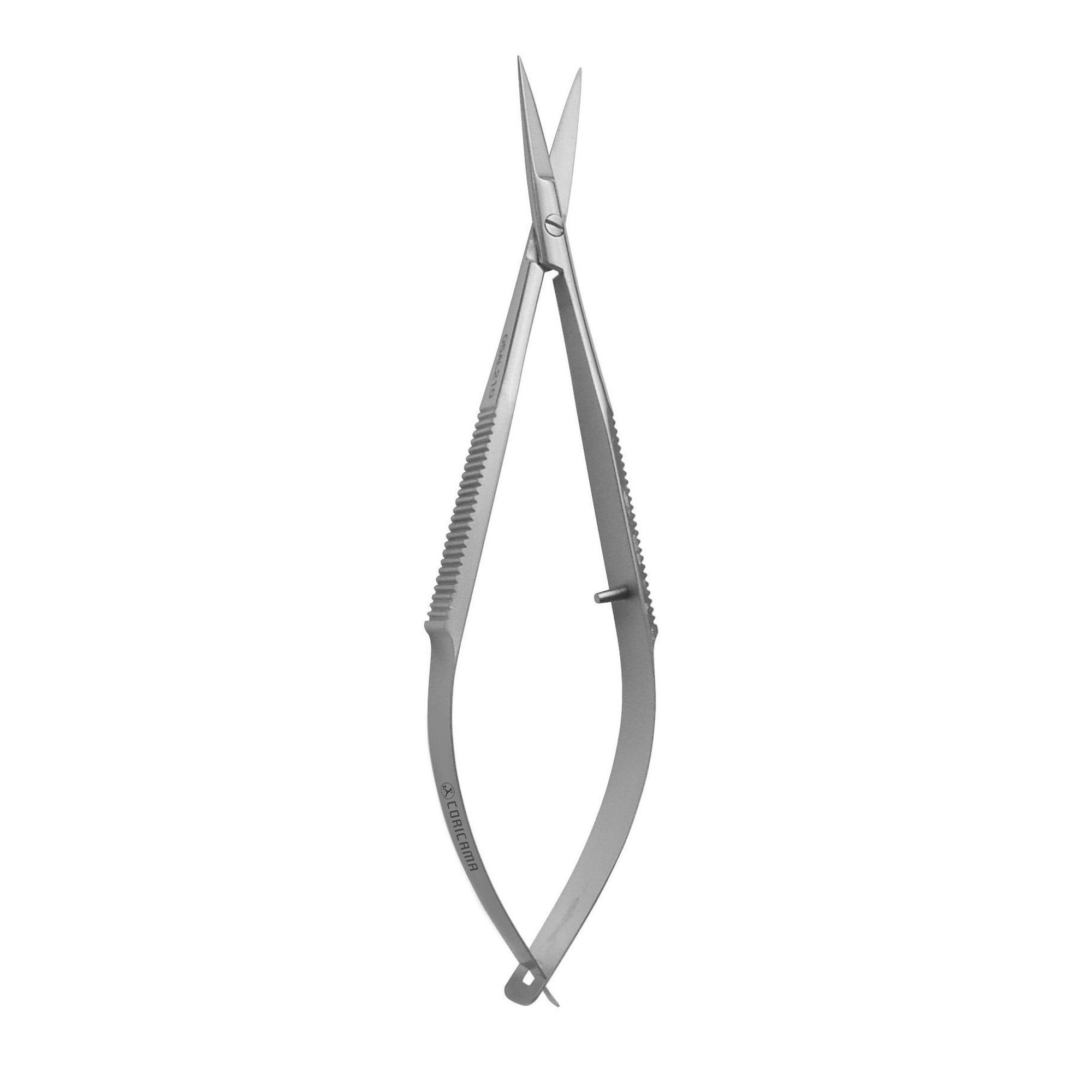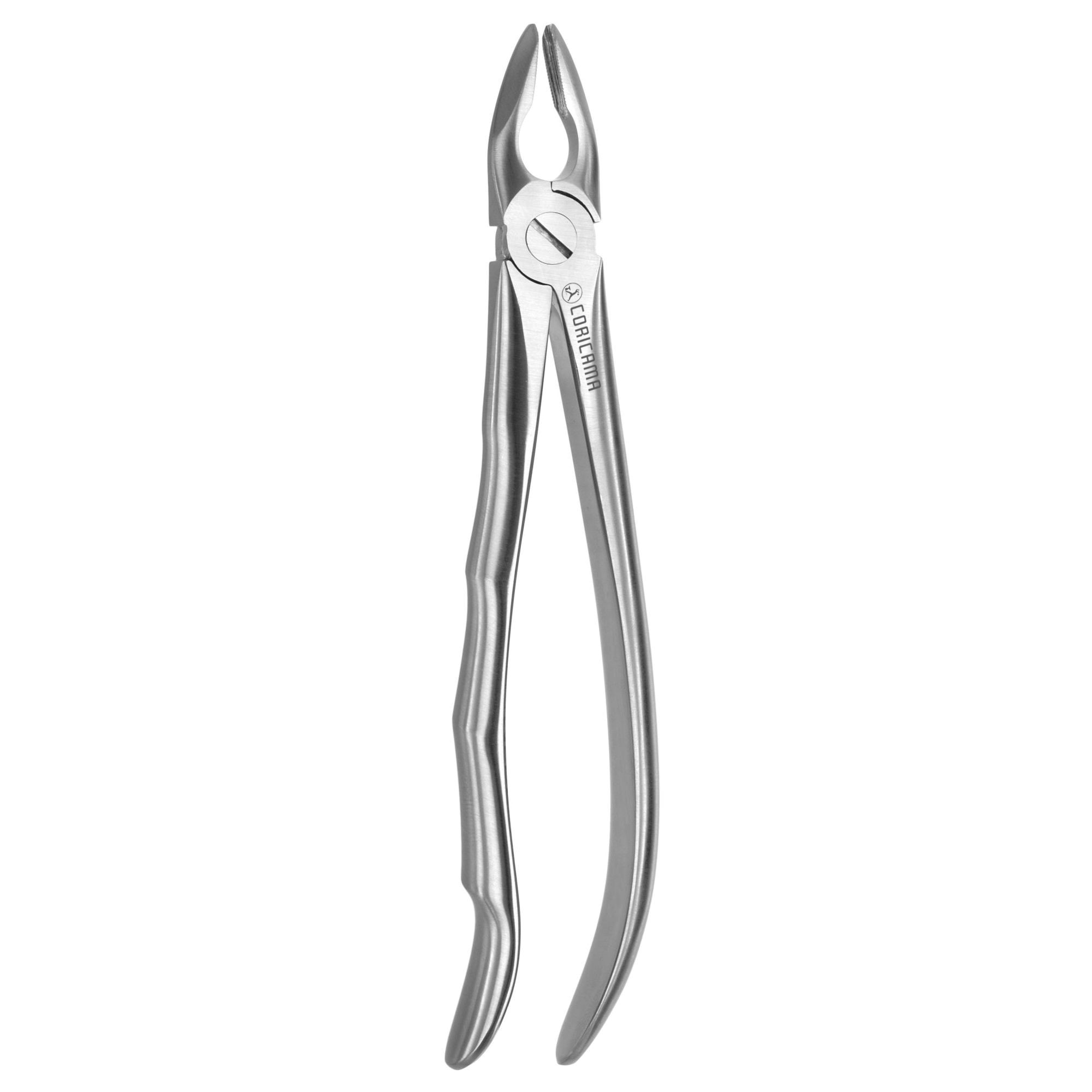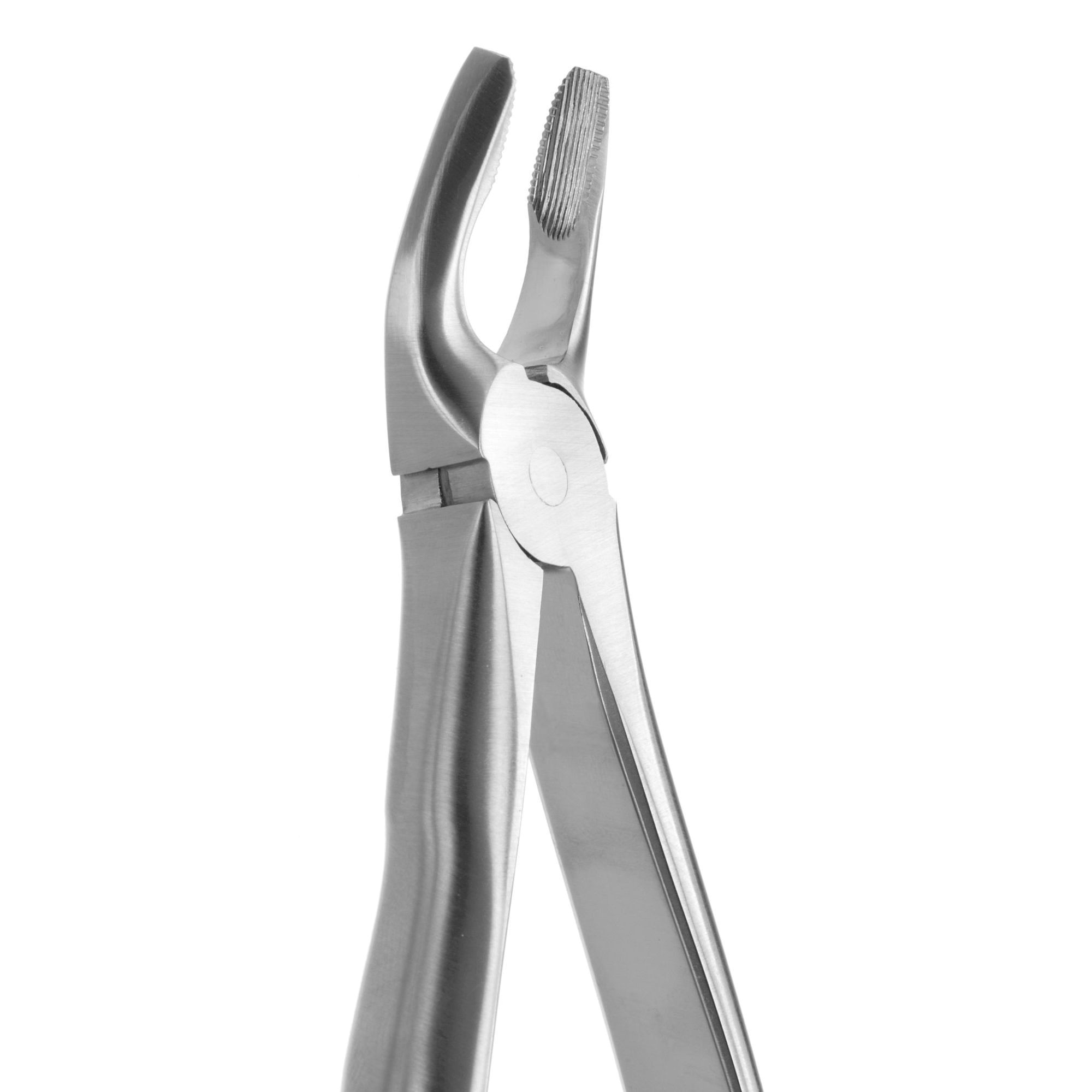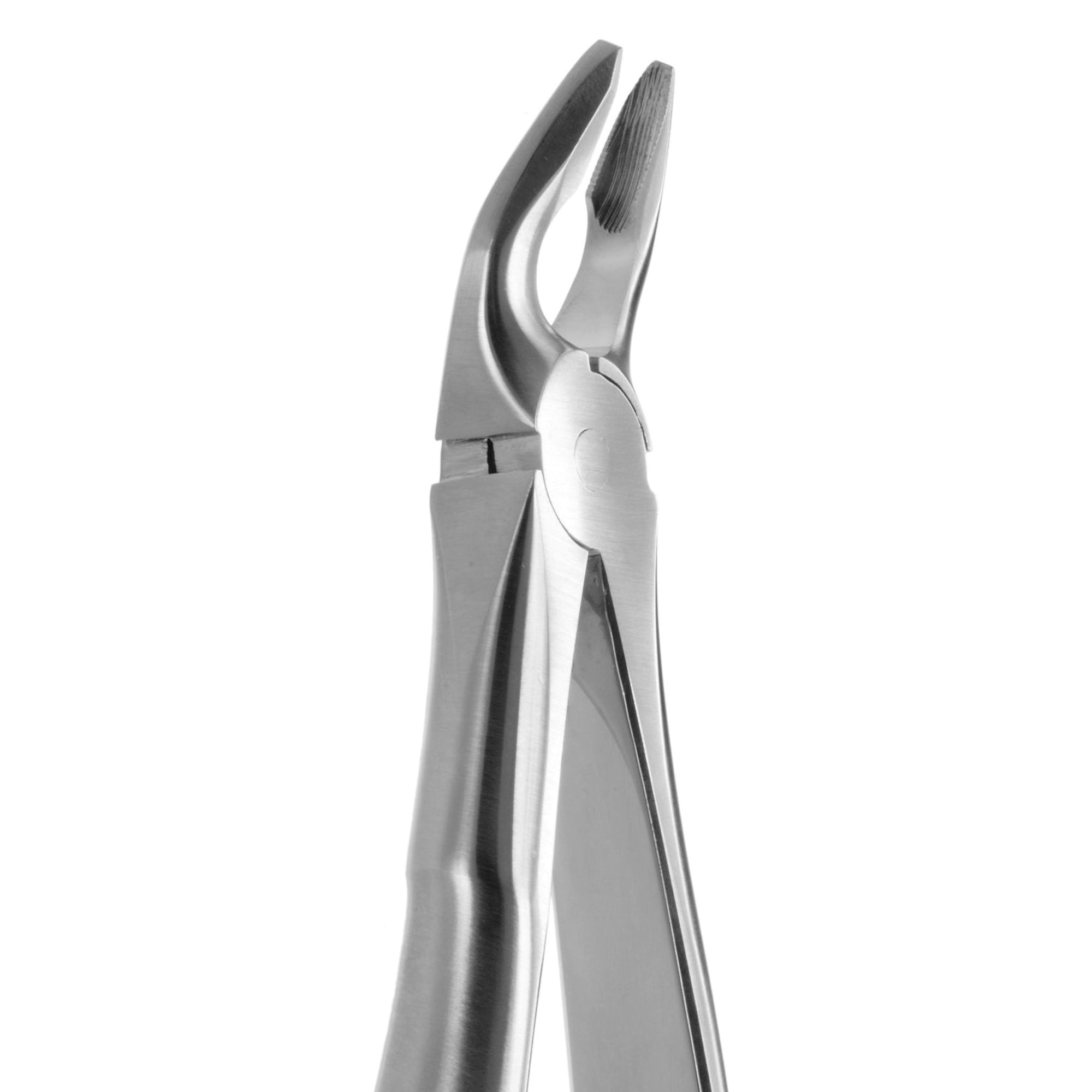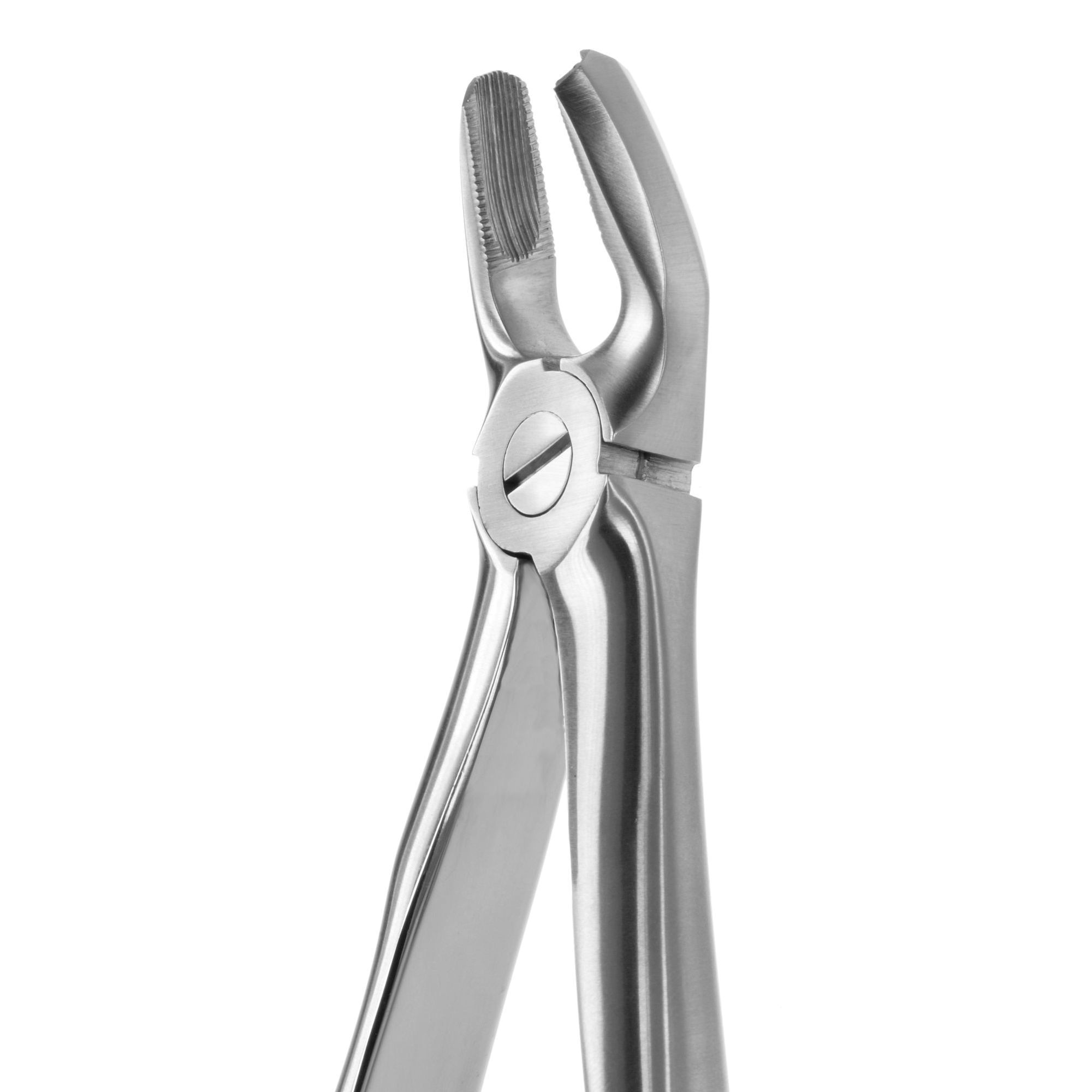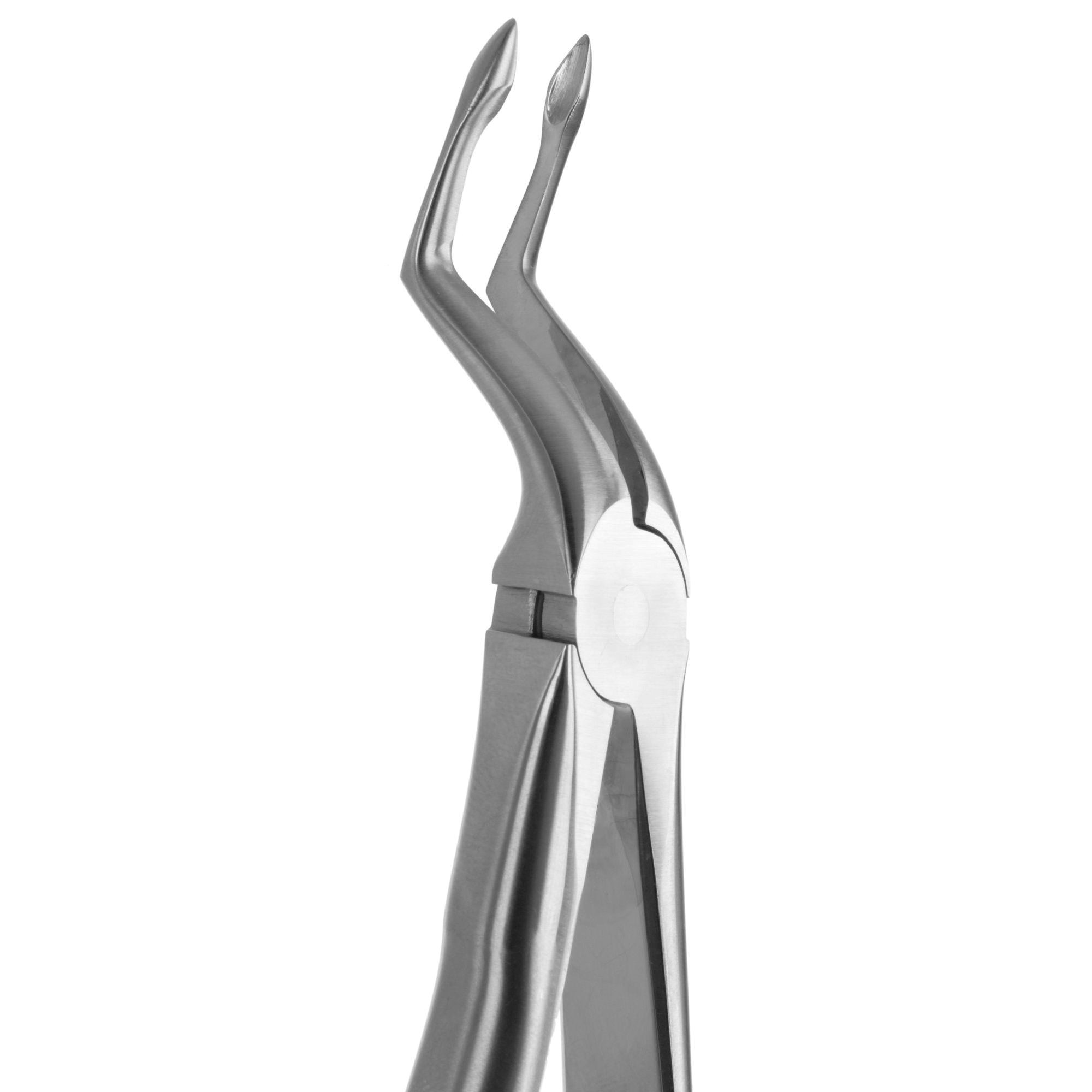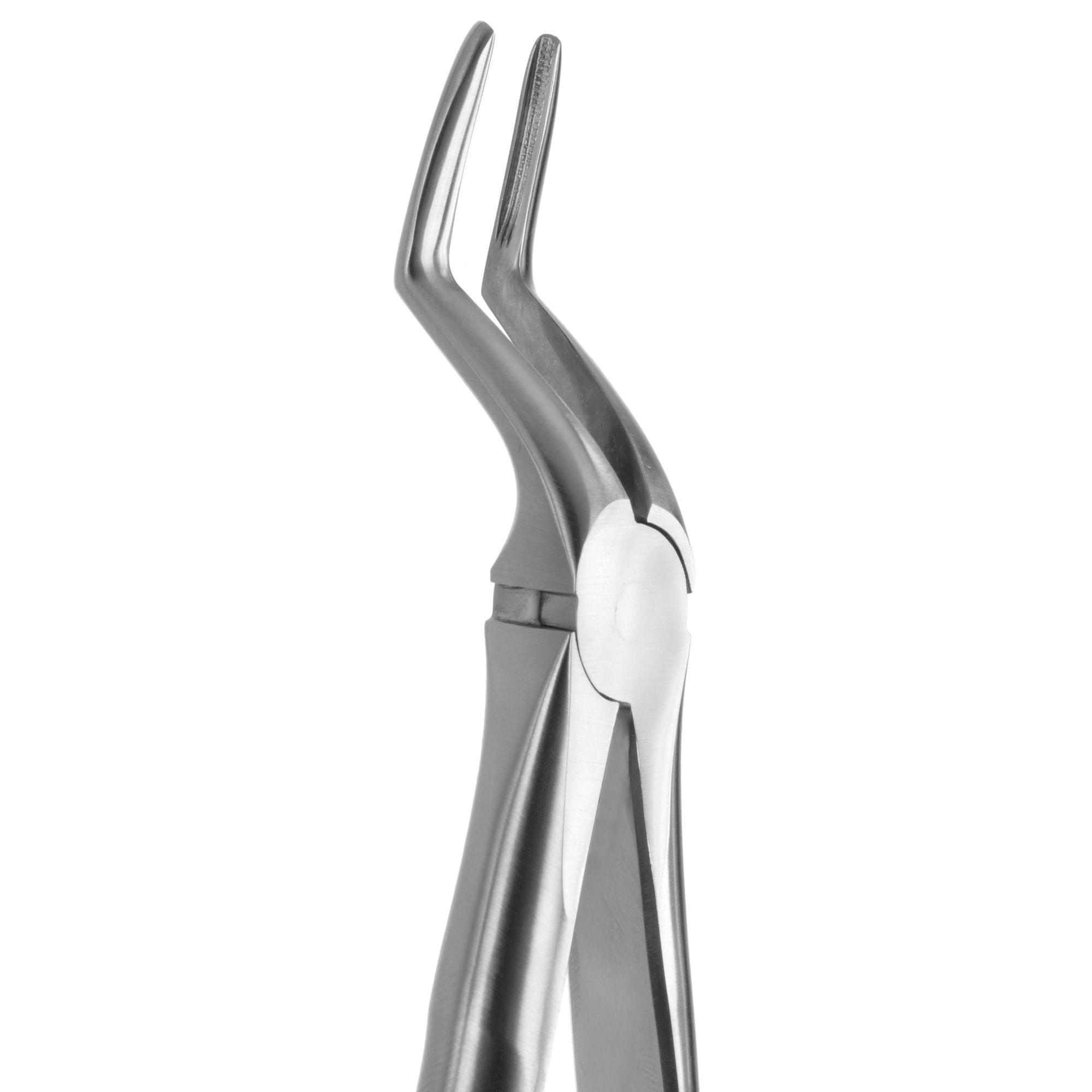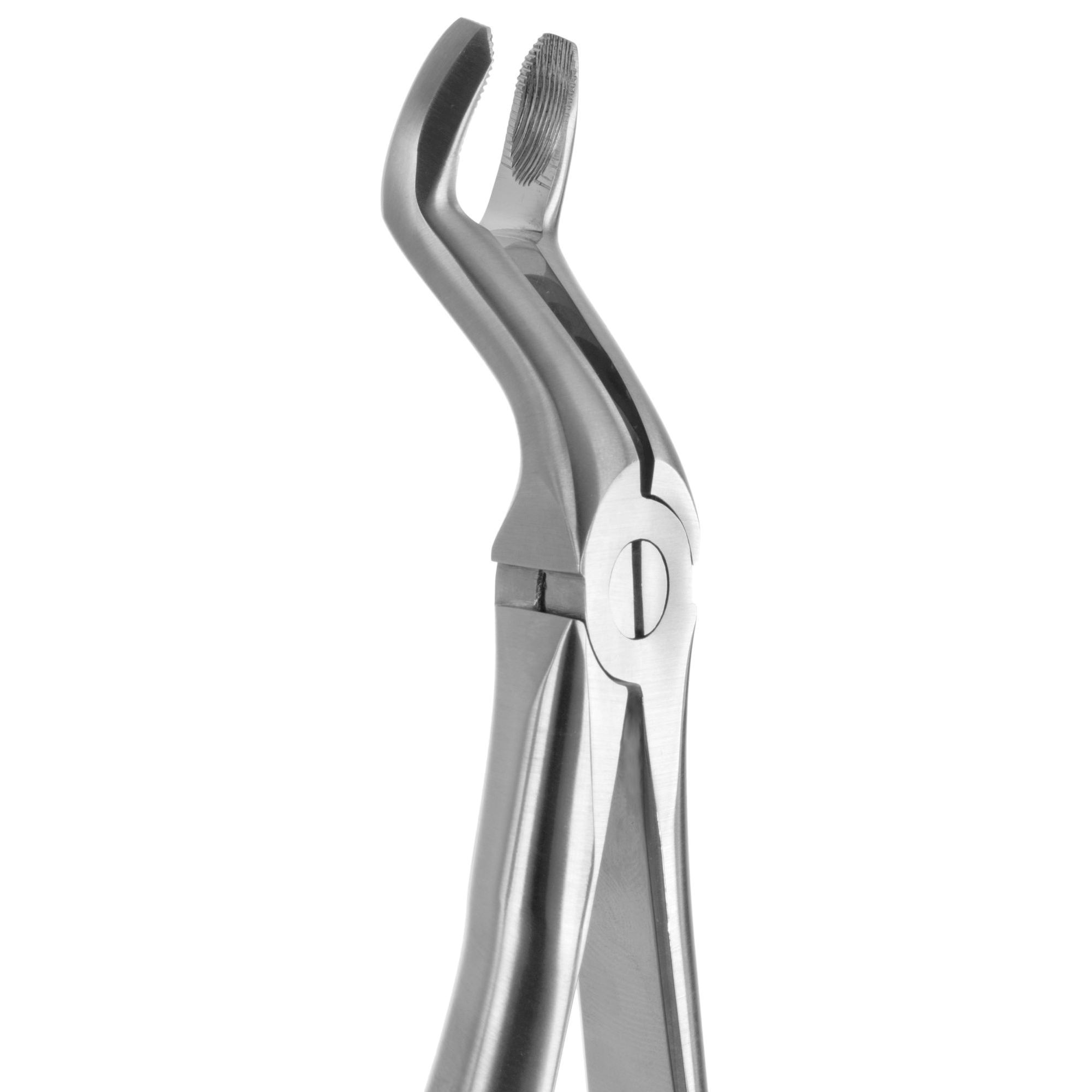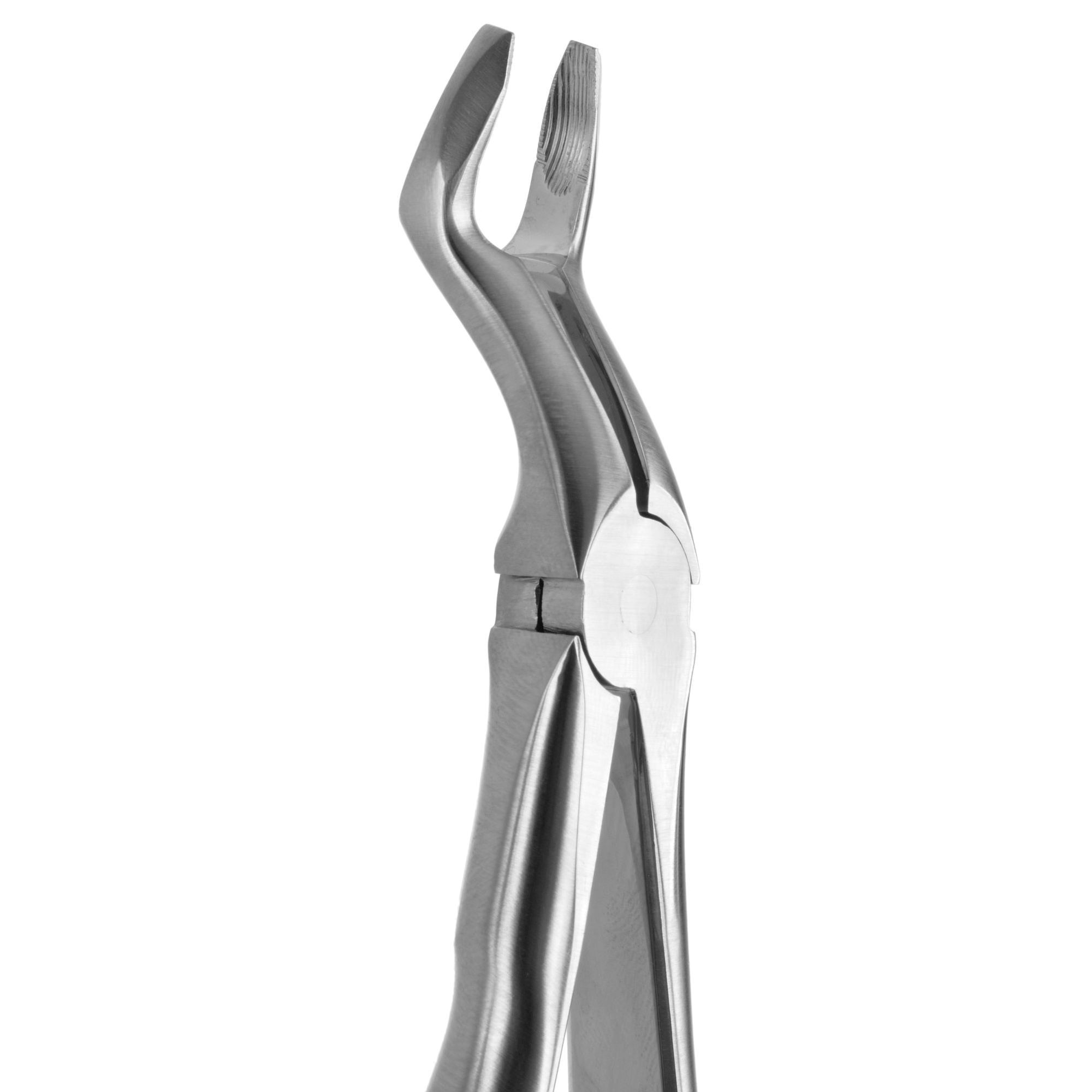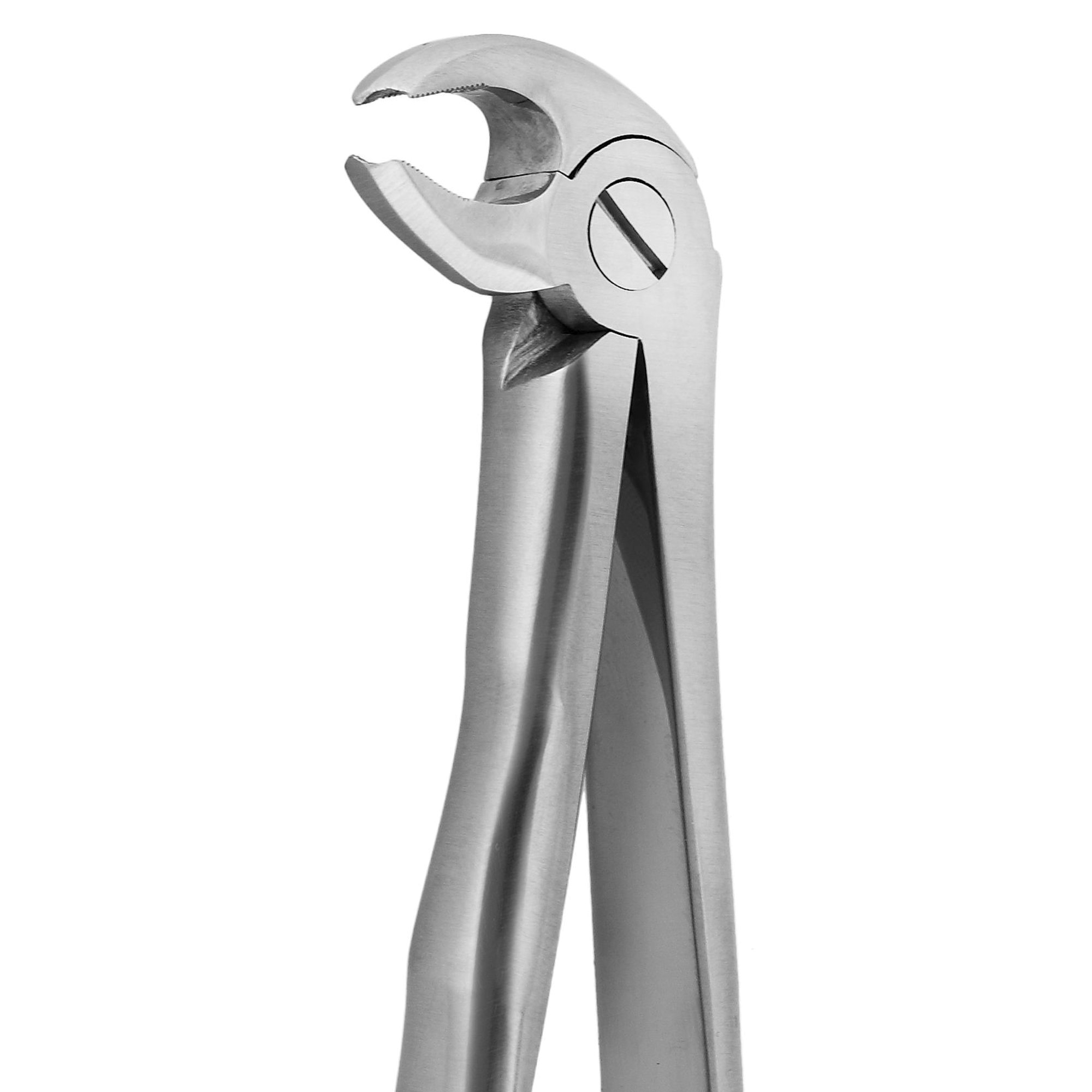Shop by Brands
Top Selling Products
Category: Instruments
-
520420
CORICAMA since 1873…. ITALIAN STYLE and ADVANCED TECHNOLOGY
CORICAMA use only the most suitable steels for the production of surgical instruments to achieve instruments that are both aesthetic and functional.
CORICAMA is a guarantee of high-quality instruments that perfectly fit to the professional sensitivity and contribute to patient well-being. CORICAMA is constantly next to the more demanding dentists and those who seek only the best for their work.
CORICAMA NEEDLE HOLDER CASTROVIEJO STRAIGHT 140MM #520420
FLAT SERRATED HANDLE
Used to grasp suture needles during suturing when pushing/pulling of the needle ans suture through tissue. It has short serrated jaws at the distal end to provide a better grip of the needle and it is available in a wide varity of sizes and designs, such as:
- Self-retaining, scissors-like design with ring handles at the proximal end.
- Tweezer-like design with bowed, hinged handles that are operated by squeezing them together.
- A heavy-duty pincer-like design.
Some types may have inserts made of hard materials (e.g. tungstan carbide) and include scissor blades.
For needles 4-O, 5-O, 6-O
Vessel dilators, rounded and polished tips can be inserted closed into the end of a divided vessel with minimal trauma.
Instrument Name : Needle Holder Castroviejo Straight 140mm #520420
Tip: Straight
Tip Material: Stainless Steel
Handle: Flat Serrated
Handle Material: Stainless Steel
-
520421
CORICAMA since 1873…. ITALIAN STYLE and ADVANCED TECHNOLOGY
CORICAMA use only the most suitable steels for the production of surgical instruments to achieve instruments that are both aesthetic and functional.
CORICAMA is a guarantee of high-quality instruments that perfectly fit to the professional sensitivity and contribute to patient well-being. CORICAMA is constantly next to the more demanding dentists and those who seek only the best for their work.
CORICAMA NEEDLE HOLDER CASTROVIEJO STRAIGHT TC 140MM #520421
FLAT SERRATED HANDLE
Used to grasp suture needles during suturing when pushing/pulling of the needle ans suture through tissue. It has short serrated jaws at the distal end to provide a better grip of the needle and it is available in a wide varity of sizes and designs, such as:
- Self-retaining, scissors-like design with ring handles at the proximal end.
- Tweezer-like design with bowed, hinged handles that are operated by squeezing them together.
- A heavy-duty pincer-like design.
Some types may have inserts made of hard materials (e.g. tungstan carbide) and include scissor blades.
For needles 4-O, 5-O, 6-O
Vessel dilators, rounded and polished tips can be inserted closed into the end of a divided vessel with minimal trauma.
Instrument Name : Needle Holder Castroviejo Straight TC 140mm #520421
Tip: Straight
Tip Material: TC Tungstan Carbide
Handle: Flat Serrated
Handle Material: Stainless Steel
-
520430
CORICAMA since 1873…. ITALIAN STYLE and ADVANCED TECHNOLOGY
CORICAMA use only the most suitable steels for the production of surgical instruments to achieve instruments that are both aesthetic and functional.
CORICAMA is a guarantee of high-quality instruments that perfectly fit to the professional sensitivity and contribute to patient well-being. CORICAMA is constantly next to the more demanding dentists and those who seek only the best for their work.
CORICAMA NEEDLE HOLDER CASTROVIEJO CURVED 140MM #520430
FLAT SERRATED HANDLE
Used to grasp suture needles during suturing when pushing/pulling of the needle ans suture through tissue. It has short serrated jaws at the distal end to provide a better grip of the needle and it is available in a wide varity of sizes and designs, such as:
- Self-retaining, scissors-like design with ring handles at the proximal end.
- Tweezer-like design with bowed, hinged handles that are operated by squeezing them together.
- A heavy-duty pincer-like design.
Some types may have inserts made of hard materials (e.g. tungstan carbide) and include scissor blades.
For needles 4-O, 5-O, 6-O
Vessel dilators, rounded and polished tips can be inserted closed into the end of a divided vessel with minimal trauma.
Instrument Name : Needle Holder Castroviejo Curved 140mm #520430
Tip: Curved
Tip Material: Stainless Steel
Handle: Flat Serrated
Handle Material: Stainless Steel
-
520431
CORICAMA since 1873…. ITALIAN STYLE and ADVANCED TECHNOLOGY
CORICAMA use only the most suitable steels for the production of surgical instruments to achieve instruments that are both aesthetic and functional.
CORICAMA is a guarantee of high-quality instruments that perfectly fit to the professional sensitivity and contribute to patient well-being. CORICAMA is constantly next to the more demanding dentists and those who seek only the best for their work.
CORICAMA NEEDLE HOLDER CASTROVIEJO CURVED TC 140MM #520431
FLAT SERRATED HANDLE
Used to grasp suture needles during suturing when pushing/pulling of the needle ans suture through tissue. It has short serrated jaws at the distal end to provide a better grip of the needle and it is available in a wide varity of sizes and designs, such as:
- Self-retaining, scissors-like design with ring handles at the proximal end.
- Tweezer-like design with bowed, hinged handles that are operated by squeezing them together.
- A heavy-duty pincer-like design.
Some types may have inserts made of hard materials (e.g. tungstan carbide) and include scissor blades.
For needles 4-O, 5-O, 6-O
Vessel dilators, rounded and polished tips can be inserted closed into the end of a divided vessel with minimal trauma.
Instrument Name : Needle Holder Castroviejo Curved TC 140mm #520431
Tip: Curved
Tip Material: TC Tungstan Carbide
Handle: Flat Serrated
Handle Material: Stainless Steel
-
520470
CORICAMA since 1873…. ITALIAN STYLE and ADVANCED TECHNOLOGY
CORICAMA use only the most suitable steels for the production of surgical instruments to achieve instruments that are both aesthetic and functional.
CORICAMA is a guarantee of high-quality instruments that perfectly fit to the professional sensitivity and contribute to patient well-being. CORICAMA is constantly next to the more demanding dentists and those who seek only the best for their work.
CORICAMA NEEDLE HOLDER CASTROVIEJO STRAIGHT 180MM #520470
FLAT SERRATED HANDLE
Used to grasp suture needles during suturing when pushing/pulling of the needle ans suture through tissue. It has short serrated jaws at the distal end to provide a better grip of the needle and it is available in a wide varity of sizes and designs, such as:
- Self-retaining, scissors-like design with ring handles at the proximal end.
- Tweezer-like design with bowed, hinged handles that are operated by squeezing them together.
- A heavy-duty pincer-like design.
Some types may have inserts made of hard materials (e.g. tungstan carbide) and include scissor blades.
For needles 4-O, 5-O, 6-O
Vessel dilators, rounded and polished tips can be inserted closed into the end of a divided vessel with minimal trauma.
Instrument Name : Needle Holder Castroviejo Straight 180mm #520470
Tip: Straight
Tip Material: Stainless Steel
Handle: Flat Serrated
Handle Material: Stainless Steel
-
520471
CORICAMA since 1873…. ITALIAN STYLE and ADVANCED TECHNOLOGY
CORICAMA use only the most suitable steels for the production of surgical instruments to achieve instruments that are both aesthetic and functional.
CORICAMA is a guarantee of high-quality instruments that perfectly fit to the professional sensitivity and contribute to patient well-being. CORICAMA is constantly next to the more demanding dentists and those who seek only the best for their work.
CORICAMA NEEDLE HOLDER CASTROVIEJO STRAIGHT TC 180MM #520471
FLAT SERRATED HANDLE
Used to grasp suture needles during suturing when pushing/pulling of the needle ans suture through tissue. It has short serrated jaws at the distal end to provide a better grip of the needle and it is available in a wide varity of sizes and designs, such as:
- Self-retaining, scissors-like design with ring handles at the proximal end.
- Tweezer-like design with bowed, hinged handles that are operated by squeezing them together.
- A heavy-duty pincer-like design.
Some types may have inserts made of hard materials (e.g. tungstan carbide) and include scissor blades.
For needles 4-O, 5-O, 6-O
Vessel dilators, rounded and polished tips can be inserted closed into the end of a divided vessel with minimal trauma.
Instrument Name : Needle Holder Castroviejo Straight TC 180mm #520471
Tip: Straight
Tip Material: TC Tungstan Carbide
Handle: Flat Serrated
Handle Material: Stainless Steel
-
520480
CORICAMA since 1873…. ITALIAN STYLE and ADVANCED TECHNOLOGY
CORICAMA use only the most suitable steels for the production of surgical instruments to achieve instruments that are both aesthetic and functional.
CORICAMA is a guarantee of high-quality instruments that perfectly fit to the professional sensitivity and contribute to patient well-being. CORICAMA is constantly next to the more demanding dentists and those who seek only the best for their work.
CORICAMA NEEDLE HOLDER CASTROVIEJO CURVED 180MM #520480
FLAT SERRATED HANDLE
Used to grasp suture needles during suturing when pushing/pulling of the needle ans suture through tissue. It has short serrated jaws at the distal end to provide a better grip of the needle and it is available in a wide varity of sizes and designs, such as:
- Self-retaining, scissors-like design with ring handles at the proximal end.
- Tweezer-like design with bowed, hinged handles that are operated by squeezing them together.
- A heavy-duty pincer-like design.
Some types may have inserts made of hard materials (e.g. tungstan carbide) and include scissor blades.
For needles 4-O, 5-O, 6-O
Vessel dilators, rounded and polished tips can be inserted closed into the end of a divided vessel with minimal trauma.
Instrument Name : Needle Holder Castroviejo Curved 180mm #5204280
Tip: Curved
Tip Material: Stainless Steel
Handle: Flat Serrated
Handle Material: Stainless Steel
-
520481
CORICAMA since 1873…. ITALIAN STYLE and ADVANCED TECHNOLOGY
CORICAMA use only the most suitable steels for the production of surgical instruments to achieve instruments that are both aesthetic and functional.
CORICAMA is a guarantee of high-quality instruments that perfectly fit to the professional sensitivity and contribute to patient well-being. CORICAMA is constantly next to the more demanding dentists and those who seek only the best for their work.
CORICAMA NEEDLE HOLDER CASTROVIEJO CURVED TC 180MM #520481
FLAT SERRATED HANDLE
Used to grasp suture needles during suturing when pushing/pulling of the needle ans suture through tissue. It has short serrated jaws at the distal end to provide a better grip of the needle and it is available in a wide varity of sizes and designs, such as:
- Self-retaining, scissors-like design with ring handles at the proximal end.
- Tweezer-like design with bowed, hinged handles that are operated by squeezing them together.
- A heavy-duty pincer-like design.
Some types may have inserts made of hard materials (e.g. tungstan carbide) and include scissor blades.
For needles 4-O, 5-O, 6-O
Vessel dilators, rounded and polished tips can be inserted closed into the end of a divided vessel with minimal trauma.
Instrument Name : Needle Holder Castroviejo Curved TC 180mm #520481
Tip: Curved
Tip Material: TC Tungstan Carbide
Handle: Flat Serrated
Handle Material: Stainless Steel
-
612210
CORICAMA since 1873…. ITALIAN STYLE and ADVANCED TECHNOLOGY
CORICAMA use only the most suitable steels for the production of surgical instruments to achieve instruments that are both aesthetic and functional.
CORICAMA is a guarantee of high-quality instruments that perfectly fit to the professional sensitivity and contribute to patient well-being. CORICAMA is constantly next to the more demanding dentists and those who seek only the best for their work.
CORICAMA TOOTH FORCEPS BLADE BEAKS UPPERS #1 #612210
Used for dental extraction (aka: tooth extraction, exodontia or exodontics): the removal of teeth from the dental alveolus (socket) in the alveolar bone.
Designed for use in specific areas of the mouth. Beaks and handles are shaped to perfectly fit the contours of the teeth and are used to easily and effectively reach the different teeth.
The operator must find the forceps with the most suitable grip and the blades should adapt to the tooth with its beaks grasping the root bifurcations. When using forceps to extract a tooth, two types of movements are made. First the gingival and periodontal ligament are cut: the blades should be positioned below the gingival margin on the buccal and lingual parts of the tooth and then driven with increasing force in anapical direction. In this way, they slide over the length of the root surface to the final part rather than gripping it from the outset. Positioning the forceps in the most apical position possible ensures that the mechanical efficiency of the subsequent extraction movements is maximal and the risk of root fracture is minimized. The second movement removes the tooth from the alveolus. Whilst the apical position reach in the first movement is maintained, the tooth should be gripped firmly with the blades and dislocated from its bony socket. This allows the alveolus to dilate and the tooth to be lifted out. The movements involved should be slow and targeted allowing the alveolus to expand; their direction will be determined by the anatomy and position of the tooth being removed.
For Upper (maxillary) incisor and canines/cuspids
With thinner tips to allow for greater depthin the cervical area and obtain a safer grip thanks to the increased contact surface.
Instrument Name: Fig #1
Tip: Serrated Thin
Tip Material: Stainless Steel
Handle: Plain Anatomic-Shaped
Handle Material: Stainless Steel
-
612220
CORICAMA since 1873…. ITALIAN STYLE and ADVANCED TECHNOLOGY
CORICAMA use only the most suitable steels for the production of surgical instruments to achieve instruments that are both aesthetic and functional.
CORICAMA is a guarantee of high-quality instruments that perfectly fit to the professional sensitivity and contribute to patient well-being. CORICAMA is constantly next to the more demanding dentists and those who seek only the best for their work.
CORICAMA TOOTH FORCEPS BLADE BEAKS UPPERS #34N #612220
Used for dental extraction (aka: tooth extraction, exodontia or exodontics): the removal of teeth from the dental alveolus (socket) in the alveolar bone.
Designed for use in specific areas of the mouth. Beaks and handles are shaped to perfectly fit the contours of the teeth and are used to easily and effectively reach the different teeth.
The operator must find the forceps with the most suitable grip and the blades should adapt to the tooth with its beaks grasping the root bifurcations. When using forceps to extract a tooth, two types of movements are made. First the gingival and periodontal ligament are cut: the blades should be positioned below the gingival margin on the buccal and lingual parts of the tooth and then driven with increasing force in an apical direction. In this way, they slide over the length of the root surface to the final part rather than gripping it from the outset. Positioning the forceps in the most apical position possible ensures that the mechanical efficiency of the subsequent extraction movements is maximal and the risk of root fracture is minimized. The second movement removes the tooth from the alveolus. Whilst the apical position reach in the first movement is maintained, the tooth should be gripped firmly with the blades and dislocated from its bony socket. This allows the alveolus to dilate and the tooth to be lifted out. The movements involved should be slow and targeted allowing the alveolus to expand; their direction will be determined by the anatomy and position of the tooth being removed.
For Upper (maxillary) centrals and canines/cuspids with narrow tips
With thinner tips to allow for greater depth in the cervical area and obtain a safer grip thanks to the increased contact surface.
Instrument Name: Fig #34N
Tip: Serrated Thin
Tip Material: Stainless Steel
Handle: Plain Anatomic-Shaped
Handle Material: Stainless Steel
-
612230
CORICAMA since 1873…. ITALIAN STYLE and ADVANCED TECHNOLOGY
CORICAMA use only the most suitable steels for the production of surgical instruments to achieve instruments that are both aesthetic and functional.
CORICAMA is a guarantee of high-quality instruments that perfectly fit to the professional sensitivity and contribute to patient well-being. CORICAMA is constantly next to the more demanding dentists and those who seek only the best for their work.
CORICAMA TOOTH FORCEPS BLADE BEAKS UPPERS #7 #612230
Used for dental extraction (aka: tooth extraction, exodontia or exodontics): the removal of teeth from the dental alveolus (socket) in the alveolar bone.
Designed for use in specific areas of the mouth. Beaks and handles are shaped to perfectly fit the contours of the teeth and are used to easily and effectively reach the different teeth.
The operator must find the forceps with the most suitable grip and the blades should adapt to the tooth with its beaks grasping the root bifurcations. When using forceps to extract a tooth, two types of movements are made. First the gingival and periodontal ligament are cut: the blades should be positioned below the gingival margin on the buccal and lingual parts of the tooth and then driven with increasing force in an apical direction. In this way, they slide over the length of the root surface to the final part rather than gripping it from the outset. Positioning the forceps in the most apical position possible ensures that the mechanical efficiency of the subsequent extraction movements is maximal and the risk of root fracture is minimized. The second movement removes the tooth from the alveolus. Whilst the apical position reach in the first movement is maintained, the tooth should be gripped firmly with the blades and dislocated from its bony socket. This allows the alveolus to dilate and the tooth to be lifted out. The movements involved should be slow and targeted allowing the alveolus to expand; their direction will be determined by the anatomy and position of the tooth being removed.
For Upper (maxillary) premolars/bicuspids
With thinner tips to allow for greater depth in the cervical area and obtain a safer grip thanks to the increased contact surface.
Instrument Name: Fig #7
Tip: Serrated Thin
Tip Material: Stainless Steel
Handle: Plain Anatomic-Shaped
Handle Material: Stainless Steel
-
612240
CORICAMA since 1873…. ITALIAN STYLE and ADVANCED TECHNOLOGY
CORICAMA use only the most suitable steels for the production of surgical instruments to achieve instruments that are both aesthetic and functional.
CORICAMA is a guarantee of high-quality instruments that perfectly fit to the professional sensitivity and contribute to patient well-being. CORICAMA is constantly next to the more demanding dentists and those who seek only the best for their work.
CORICAMA Tooth Forceps Blade Beaks #35-N #612240
Used for dental extraction (aka: tooth extraction, exodontia or exodontics): the removal of teeth from the dental alveolus (socket) in the alveolar bone.
Designed for use in specific areas of the mouth. Beaks and handles are shaped to perfectly fit the contours of the teeth and are used to easily and effectively reach the different teeth
The operator must find the forceps with the most suitable grip and the blades should adapt to the tooth with its beaks grasping the root bifurcations. When using forceps to extract a tooth, two types of movements are made. First the gingival and periodontal ligament are cut: the blades should be positioned below the gingival margin on the buccal and lingual parts of the tooth and then driven with increasing force in an apical direction. In this way, they slide over the length of the root surface to the final part rather than gripping it from the outset. Positioning the forceps in the most apical position possible ensures that the mechanical efficiency of the subsequent extraction movements is maximal and the risk of root fracture is minimized. The second movement removes the tooth from the alveolus. Whilst the apical position reach in the first movement is maintained, the tooth should be gripped firmly with the blades and dislocated from its bony socket. This allows the alveolus to dilate and the tooth to be lifted out. The movements involved should be slow and targeted allowing the alveolus to expand; their direction will be determined by the anatomy and position of the tooth being removed.
Upper (maxillary) premolars/bicuspids with narrow tips.
Instrument Name: Tooth Forcep #35-N
Tip: Serrated Thin.
Tip Material: Stainless Steel.
Handle: Anatomic.
Handle Material: Stainless Steel.
-
612250
CORICAMA since 1873…. ITALIAN STYLE and ADVANCED TECHNOLOGY
CORICAMA use only the most suitable steels for the production of surgical instruments to achieve instruments that are both aesthetic and functional.
CORICAMA is a guarantee of high-quality instruments that perfectly fit to the professional sensitivity and contribute to patient well-being. CORICAMA is constantly next to the more demanding dentists and those who seek only the best for their work.
CORICAMA TOOTH FORCEPS BLADE BEAKS UPPERS #17 #612250
Used for dental extraction (aka: tooth extraction, exodontia or exodontics): the removal of teeth from the dental alveolus (socket) in the alveolar bone.
Designed for use in specific areas of the mouth. Beaks and handles are shaped to perfectly fit the contours of the teeth and are used to easily and effectively reach the different teeth.
The operator must find the forceps with the most suitable grip and the blades should adapt to the tooth with its beaks grasping the root bifurcations. When using forceps to extract a tooth, two types of movements are made. First the gingival and periodontal ligament are cut: the blades should be positioned below the gingival margin on the buccal and lingual parts of the tooth and then driven with increasing force in an apical direction. In this way, they slide over the length of the root surface to the final part rather than gripping it from the outset. Positioning the forceps in the most apical position possible ensures that the mechanical efficiency of the subsequent extraction movements is maximal and the risk of root fracture is minimized. The second movement removes the tooth from the alveolus. Whilst the apical position reach in the first movement is maintained, the tooth should be gripped firmly with the blades and dislocated from its bony socket. This allows the alveolus to dilate and the tooth to be lifted out. The movements involved should be slow and targeted allowing the alveolus to expand; their direction will be determined by the anatomy and position of the tooth being removed.
For Upper (maxillary) molars right
With thinner tips to allow for greater depth in the cervical area and obtain a safer grip thanks to the increased contact surface. Paired with #18
Instrument Name: Fig #17
Tip: Serrated Thin
Tip Material: Stainless Steel
Handle: Plain Anatomic-Shaped
Handle Material: Stainless Steel
-
612260
ORICAMA since 1873…. ITALIAN STYLE and ADVANCED TECHNOLOGY
CORICAMA use only the most suitable steels for the production of surgical instruments to achieve instruments that are both aesthetic and functional.
CORICAMA is a guarantee of high-quality instruments that perfectly fit to the professional sensitivity and contribute to patient well-being. CORICAMA is constantly next to the more demanding dentists and those who seek only the best for their work.
CORICAMA TOOTH FORCEPS BLADE BEAKS UPPERS #18 #612260
Used for dental extraction (aka: tooth extraction, exodontia or exodontics): the removal of teeth from the dental alveolus (socket) in the alveolar bone.
Designed for use in specific areas of the mouth. Beaks and handles are shaped to perfectly fit the contours of the teeth and are used to easily and effectively reach the different teeth.
The operator must find the forceps with the most suitable grip and the blades should adapt to the tooth with its beaks grasping the root bifurcations. When using forceps to extract a tooth, two types of movements are made. First the gingival and periodontal ligament are cut: the blades should be positioned below the gingival margin on the buccal and lingual parts of the tooth and then driven with increasing force in an apical direction. In this way, they slide over the length of the root surface to the final part rather than gripping it from the outset. Positioning the forceps in the most apical position possible ensures that the mechanical efficiency of the subsequent extraction movements is maximal and the risk of root fracture is minimized. The second movement removes the tooth from the alveolus. Whilst the apical position reach in the first movement is maintained, the tooth should be gripped firmly with the blades and dislocated from its bony socket. This allows the alveolus to dilate and the tooth to be lifted out. The movements involved should be slow and targeted allowing the alveolus to expand; their direction will be determined by the anatomy and position of the tooth being removed.
For Upper (maxillary) molars left
With thinner tips to allow for greater depth in the cervical area and obtain a safer grip thanks to the increased contact surface. Paired with #17
Instrument Name: Fig #18
Tip: Serrated Thin
Tip Material: Stainless Steel
Handle: Plain Anatomic-Shaped
Handle Material: Stainless Steel
-
612270
CORICAMA since 1873…. ITALIAN STYLE and ADVANCED TECHNOLOGY
CORICAMA use only the most suitable steels for the production of surgical instruments to achieve instruments that are both aesthetic and functional.
CORICAMA is a guarantee of high-quality instruments that perfectly fit to the professional sensitivity and contribute to patient well-being. CORICAMA is constantly next to the more demanding dentists and those who seek only the best for their work.
CORICAMA TOOTH FORCEPS BLADE BEAKS UPPERS #51 #612270
Used for dental extraction (aka: tooth extraction, exodontia or exodontics): the removal of teeth from the dental alveolus (socket) in the alveolar bone.
Designed for use in specific areas of the mouth. Beaks and handles are shaped to perfectly fit the contours of the teeth and are used to easily and effectively reach the different teeth.
The operator must find the forceps with the most suitable grip and the blades should adapt to the tooth with its beaks grasping the root bifurcations. When using forceps to extract a tooth, two types of movements are made. First the gingival and periodontal ligament are cut: the blades should be positioned below the gingival margin on the buccal and lingual parts of the tooth and then driven with increasing force in an apical direction. In this way, they slide over the length of the root surface to the final part rather than gripping it from the outset. Positioning the forceps in the most apical position possible ensures that the mechanical efficiency of the subsequent extraction movements is maximal and the risk of root fracture is minimized. The second movement removes the tooth from the alveolus. Whilst the apical position reach in the first movement is maintained, the tooth should be gripped firmly with the blades and dislocated from its bony socket. This allows the alveolus to dilate and the tooth to be lifted out. The movements involved should be slow and targeted allowing the alveolus to expand; their direction will be determined by the anatomy and position of the tooth being removed.
For Upper (maxillary) roots narrow short head
With thinner tips to allow for greater depth in the cervical area and obtain a safer grip thanks to the increased contact surface.
Instrument Name: Fig #51
Tip: Serrated Thin
Tip Material: Stainless Steel
Handle: Plain Anatomic-Shaped
Handle Material: Stainless Steel
-
612275
CORICAMA since 1873…. ITALIAN STYLE and ADVANCED TECHNOLOGY
CORICAMA use only the most suitable steels for the production of surgical instruments to achieve instruments that are both aesthetic and functional.
CORICAMA is a guarantee of high-quality instruments that perfectly fit to the professional sensitivity and contribute to patient well-being. CORICAMA is constantly next to the more demanding dentists and those who seek only the best for their work.
CORICAMA TOOTH FORCEPS BLADE BEAKS UPPERS #51-AL #612275
Used for dental extraction (aka: tooth extraction, exodontia or exodontics): the removal of teeth from the dental alveolus (socket) in the alveolar bone.
Designed for use in specific areas of the mouth. Beaks and handles are shaped to perfectly fit the contours of the teeth and are used to easily and effectively reach the different teeth.
The operator must find the forceps with the most suitable grip and the blades should adapt to the tooth with its beaks grasping the root bifurcations. When using forceps to extract a tooth, two types of movements are made. First the gingival and periodontal ligament are cut: the blades should be positioned below the gingival margin on the buccal and lingual parts of the tooth and then driven with increasing force in an apical direction. In this way, they slide over the length of the root surface to the final part rather than gripping it from the outset. Positioning the forceps in the most apical position possible ensures that the mechanical efficiency of the subsequent extraction movements is maximal and the risk of root fracture is minimized. The second movement removes the tooth from the alveolus. Whilst the apical position reach in the first movement is maintained, the tooth should be gripped firmly with the blades and dislocated from its bony socket. This allows the alveolus to dilate and the tooth to be lifted out. The movements involved should be slow and targeted allowing the alveolus to expand; their direction will be determined by the anatomy and position of the tooth being removed.
For Upper (maxillary) roots
With thinner tips to allow for greater depth in the cervical area and obtain a safer grip thanks to the increased contact surface.
Instrument Name: Fig #51-AL
Tip: Serrated Thin
Tip Material: Stainless Steel
Handle: Plain Anatomic-Shaped
Handle Material: Stainless Steel
-
612280
CORICAMA since 1873…. ITALIAN STYLE and ADVANCED TECHNOLOGY
CORICAMA use only the most suitable steels for the production of surgical instruments to achieve instruments that are both aesthetic and functional.
CORICAMA is a guarantee of high-quality instruments that perfectly fit to the professional sensitivity and contribute to patient well-being. CORICAMA is constantly next to the more demanding dentists and those who seek only the best for their work.
CORICAMA TOOTH FORCEPS BLADE BEAKS UPPERS #67 #612280
Used for dental extraction (aka: tooth extraction, exodontia or exodontics): the removal of teeth from the dental alveolus (socket) in the alevolar bone.
Designed for use in specific areas of the mouth. Beaks and handles are shaped to perfectly fit the contours of the teeth and are used to easily and effectively reach the different teeth.
The operator must find the forceps with the most suitable grip and the blades should adapt to the tooth with its beaks grasping the root bifurcations. When using forceps to extract a tooth, two types of movements are made. First the gingival and periodontal ligament are cut: the blades should be positioned below the gingival margin on the buccal and lingual parts of the tooth and then driven with increasing force in an apical direction. In this way, they slide over the length of the root surface to the final part rather than gripping it from the outset. Positioning the forceps in the most apical position possible ensures that the mechanical efficiency of the subsequent extraction movements is maximal and the risk of root fracture is minimized. The second movement removes the tooth from the alveolus. Whilst the apical position reach in the first movement is maintained, the tooth should be gripped firmly with the blades and dislocated from its bony socket. This allows the alveolus to dilate and the tooth to be lifted out. The movements involved should be slow and targeted allowing the alveolus to expand; their direction will be determined by the anatomy and position of the tooth being removed.
For Upper (maxillary) upper wisdoms, third molars
With thinner tips to allow for greater depth in the cervical area and obtain a safer grip thanks to the increased contact surface.
Instrument Name: Fig #67
Tip: Serrated Thin
Tip Material: Stainless Steel
Handle: Plain Anatomic-Shaped
Handle Material: Stainless Steel
-
612285
CORICAMA since 1873…. ITALIAN STYLE and ADVANCED TECHNOLOGY
CORICAMA use only the most suitable steels for the production of surgical instruments to achieve instruments that are both aesthetic and functional.
CORICAMA is a guarantee of high-quality instruments that perfectly fit to the professional sensitivity and contribute to patient well-being. CORICAMA is constantly next to the more demanding dentists and those who seek only the best for their work.
CORICAMA TOOTH FORCEPS BLADE BEAKS UPPERS #67-N #612285
Used for dental extraction (aka: tooth extraction, exodontia or exodontics): the removal of teeth from the dental alveolus (socket) in the alveolar bone.
Designed for use in specific areas of the mouth. Beaks and handles are shaped to perfectly fit the contours of the teeth and are used to easily and effectively reach the different teeth.
The operator must find the forceps with the most suitable grip and the blades should adapt to the tooth with its beaks grasping the root bifurcations. When using forceps to extract a tooth, two types of movements are made. First the gingival and periodontal ligament are cut: the blades should be positioned below the gingival margin on the buccal and lingual parts of the tooth and then driven with increasing force in an apical direction. In this way, they slide over the length of the root surface to the final part rather than gripping it from the outset. Positioning the forceps in the most apical position possible ensures that the mechanical efficiency of the subsequent extraction movements is maximal and the risk of root fracture is minimized. The second movement removes the tooth from the alveolus. Whilst the apical position reach in the first movement is maintained, the tooth should be gripped firmly with the blades and dislocated from its bony socket. This allows the alveolus to dilate and the tooth to be lifted out. The movements involved should be slow and targeted allowing the alveolus to expand; their direction will be determined by the anatomy and position of the tooth being removed.
For Upper (maxillary) wisdom teeth, third molars, narrow tips
With thinner tips to allow for greater depth in the cervical area and obtain a safer grip thanks to the increased contact surface.
Instrument Name: Fig #67-N
Tip: Serrated Thin
Tip Material: Stainless Steel
Handle: Plain Anatomic-Shaped
Handle Material: Stainless Steel
-
612410
CORICAMA since 1873…. ITALIAN STYLE and ADVANCED TECHNOLOGY
CORICAMA use only the most suitable steels for the production of surgical instruments to achieve instruments that are both aesthetic and functional.
CORICAMA is a guarantee of high-quality instruments that perfectly fit to the professional sensitivity and contribute to patient well-being. CORICAMA is constantly next to the more demanding dentists and those who seek only the best for their work.
CORICAMA TOOTH FORCEPS BLADE BEAKS LOWERS #22 #612410
Used for dental extraction (aka: tooth extraction, exodontia or exodontics): the removal of teeth from the dental alveolus (socket) in the alveolar bone.
Designed for use in specific areas of the mouth. Beaks and handles are shaped to perfectly fit the contours of the teeth and are used to easily and effectively reach the different teeth.
The operator must find the forceps with the most suitable grip and the blades should adapt to the tooth with its beaks grasping the root bifurcations. When using forceps to extract a tooth, two types of movements are made. First the gingival and periodontal ligament are cut: the blades should be positioned below the gingival margin on the buccal and lingual parts of the tooth and then driven with increasing force in an apical direction. In this way, they slide over the length of the root surface to the final part rather than gripping it from the outset. Positioning the forceps in the most apical position possible ensures that the mechanical efficiency of the subsequent extraction movements is maximal and the risk of root fracture is minimized. The second movement removes the tooth from the alveolus. Whilst the apical position reach in the first movement is maintained, the tooth should be gripped firmly with the blades and dislocated from its bony socket. This allows the alveolus to dilate and the tooth to be lifted out. The movements involved should be slow and targeted allowing the alveolus to expand; their direction will be determined by the anatomy and position of the tooth being removed.
For Lower (mandibular) molars
With thinner tips to allow for greater depth in the cervical area and obtain a safer grip thanks to the increased contact surface.
Instrument Name: Fig #22
Tip: Serrated Thin
Tip Material: Stainless Steel
Handle: Plain Anatomic-Shaped
Handle Material: Stainless Steel

